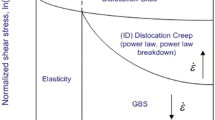Abstract
An experimental procedure is developed to identify and quantify a connection between compressive creep and the evolution of fracture toughness. Specifically, it is determined that an accumulation of compressive creep leads to a reduction in fracture toughness. Insight into the mechanism responsible for this observed behavior is pursued. Fractography performed following the fracture toughness tests shows a transition from ductile to brittle failure caused by the presence of residual creep. The quantified effect of compressive creep on fracture toughness is applied in a thermomechanical fatigue (TMF) model to simulate crack propagation in the single crystal nickel-based superalloy PWA 1484. Considering the coupling between compressive creep and decreased crack resistance led to significantly improved TMF life prediction. Further application of the developed experimental procedure to fully quantify the evolution of fracture toughness as a function of creep accumulation will lead to greater TMF and structural life predictive capabilities. This finding has implications for a wide variety of materials and applications involving high temperature dwell fatigue including in the aerospace, energy, and manufacturing sectors.






Similar content being viewed by others
References
Amaro RL, Antolovich SD, Neu RW, Staroselsky A (2010) On thermo-mechanical fatigue in single crystal Ni-base superalloys. Proc Eng 2:815–824
ASTM E1820-16 (2016) Standard test method for measurement of fracture toughness. ASTM International, West Conshohocken www.astm.org
Borkowski L, Staroselsky A, Attridge P, Wang X, Martin T, Farris J (2016) Thermomechanical fatigue crack propagation in turbine blade material. Turbine Engine Technology Symposium (TETS), Dayton
Dassault Systemes (2017) Modeling discontinuities as an enriched feature using the extended finite element method. Abaqus/Standard User’s Manual
Kersey RK, Staroselsky A, Dudzinski DC, Genest M (2013) Thermomechanical fatigue crack growth from laser drilled holes in single crystal nickel based superalloy. Int J Fatigue 55:183–193
Mehmanparast A, Davies CM (2018) The influence of inelastic pre-straining on fracture toughness behaviour of Type 316H stainless steel. Eng Fract Mech 188:112–125
Staroselsky A, Cassenti BN (2011) Creep, plasticity, and fatigue of single crystal superalloy. Int J Solids Struct 48(13):2060–2075
Staroselsky A, Martin TJ (2015) Creep, plasticity and fatigue of single crystal superalloys: physics-based life prediction for turbine components in severe operating environments. In: Altenbach H, Brünig M (eds) Inelastic behavior of materials and structures under monotonic and cyclic loading. Advanced structured materials, vol 57. Springer, Cham
Author information
Authors and Affiliations
Corresponding author
Additional information
Publisher's Note
Springer Nature remains neutral with regard to jurisdictional claims in published maps and institutional affiliations.
Rights and permissions
About this article
Cite this article
Borkowski, L.B., Staroselsky, A. Effect of compressive creep on fracture toughness: application to thermomechanical fatigue (TMF) life prediction. Int J Fract 222, 231–236 (2020). https://doi.org/10.1007/s10704-020-00434-6
Received:
Accepted:
Published:
Issue Date:
DOI: https://doi.org/10.1007/s10704-020-00434-6




